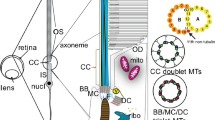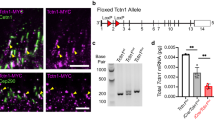Summary
Examination of the ultrastructure of retinula cells of the Australian crayfish Cherax destructor at different times over a 24-hour cycle, together with patterns of anti-rhodopsin antigenicity, has lead to the formulation of a model of photoreceptor membrane turnover in these animals. Its main features are: (a) the existence of two bursts of rhabdomeral membrane breakdown; one, light-sensitive and synchronous, occurring at dawn, the other, constituting the first part of the membrane replacement phase itself, occurring during the afternoon and night, (b) the desynchronisation of the replacement phase of turnover between animals and to a lesser extent between cells of the same retina, (c) confinement of ultrastructurally detectable signs of photoreceptor membrane processing to the retinula cells themselves, and (d) replacement of a substantial part if not all of the rhabdomeral membrane daily. This model is compatible with many of the observations reported on the American crayfish Procambarus, and utilises the same basic mechanisms that are believed to operate in photoreceptor membrane turnover in many other arthropod compound eyes.
Similar content being viewed by others
References
Arikawa K, Kawamata K, Suzuki T, Eguchi E (1987) Daily changes of structure, function and rhodopsin content in the compound eye of the crab Hemigrapsus sanguineus. J Comp Physiol A 161:1161–174
Barrett AJ, Kembhavi AA, Brown MA, Krischke H, Knight CG, Tamai M, Hanada K (1982) L-trans-epoxysuccinyl-leucylamido(4-guanidino)butane (E-64) and its analogues as inhibitors of cysteine proteases including cathepsins B, H and L. Biochem J 201:189–198
Bendayan M, Nanci A, Kan FWK (1987) Effect of tissue processing on colloidal gold cytochemistry. J Histochem Cytochem 35:983–996
Blest AD (1988) The turnover of phototransductive membrane in compound eyes and ocelli. Adv in Insect Physiol 20:1–53
Blest AD, Eddey W (1984) The extrarhabdomeral cytoskeleton in photoreceptors of Diptera. II. Plasmalemmal undercoats. Proc R Soc Lond [Biol] 220:353–359
Blest AD, Maples J (1979) Exocytotic shedding and glial uptake of photoreceptor membrane by a salticid spider. Proc Roy Soc Lond [Biol] 204:105–112
Blest AD, Stowe S, Price DG (1980) The sources of acid hydrolases for photoreceptor membrane degradation in a grapsid crab. Cell Tissue Res 205:229–244
Blest AD, Stowe S, Eddey W (1982) A labile, Ca2+-dependent cytoskeleton in the rhabdomeral microvilli of blowflies. Cell Tissue Res 223:553–573
Bryceson KP (1986) Diurnal changes in photoreceptor sensitivity in a reflecting superposition eye. J Comp Physiol 158:573–582
Bryceson KP, McIntyre P (1983) Image quality and acceptance angle in a reflecting superposition eye. J Comp Physiol 151:67–380
Couet HG de, Sigmund C (1985) Monoclonal antibodies to crayfish rhodopsin: I. Biochemical characterisation and cross-reactivity. Eur J Cell Biol 38:106–112
Couet HG de, Stowe S, Blest AD (1984) Membrane-associated actin in the rhabdomeral microvilli of crayfish receptors. J Cell Biol 98:834–846
Craig S, Goodchild DJ (1982) Post-embedding immunolabelling. Some effects of tissue preparation on the antigenicity of plant proteins. Eur J Cell Biol 28:251–256
Cronin TW, Goldsmith TH (1984) Dark regeneration of rhodopsin in crayfish photoreceptors. J Gen Physiol 84:63–81
Doughtie DG, Rao KR (1984) Ultrastructure of the eyes of the gras shrimp, Palaemonetes pugio. Cell Tissue Res 238:271–288
Eguchi G, Waterman TH (1967) Changes in retinal fine structure induced in the crab Libinia by light and dark adaptation. Z Zellforsch 79:209–229
Eguchi E, Waterman TH (1976) Freeze-etch and histochemical evidence for cycling in crayfish photoreceptor membrane. Cell Tissue Res 169:419–434
Franke WW, Schmid E, Grund C, Geiger B (1982) Intermediate filament proteins in non-filamentous structures: transient disintregation and inclusion of subunit proteins in granular aggregates. Cell 30:103–113
Frixione E, Porter RM (1986) Volume and surface changes of smooth endoplasmic reticulum in crayfish retinula cells upon light- and dark-adaptation. J Comp Physiol A 159:667–674
Goldsmith TH, Wehner R (1977) Restrictions on rotational and translational diffusion of pigment in the membranes of a rhabdomeric photoreceptor. J Gen Physiol 70:453–490
Hafner GS, Tokarski TR (1988) The diurnal pattern of protein and photopigment synthesis in the retina of the crayfish, Procambarus clarkii. J Comp Physiol A 163:253–258
Hafner GS, Hammond-Soltis G, Tokarski T (1980) Diurnal changes of lysosome-related bodies in the crayfish photoreceptor cells. Cell Tissue Res 206:319–332
Hallberg E (1978) The compound eye of crustaceans and its screening pigment. Thesis, Department of Zoology, University of Lund, Lund, Sweden
Hanada K, Tamai N, Yamagishi M, Ohmura S, Sawada J, Tanaka I (1978) Isolation and characterization of E-64, a new thiol protease inhibitor. Agric Biol Chem 42:523–528
Harreveld A van (1936) A physiological solution for freshwater crustaceans. Proc Soc Exp Biol Med 34:428–432
Itaya SK (1976) Rhabdom changes in the shrimp Palaemonetes. Cell Tissue Res 166:265–273
Matsumoto-Suzuki E, Hirosawa K, Hotta Y (1989) Structure of the subrhadomeric cisternae in the photoreceptor cells of Drosophila melanogaster. J Neurocytol 18:87–93
Meyer-Rochow VB, Tiang KM (1979) The effects of light and temperature on the structural organisation of the eye of the Antarctic amphipod Orchomene plebs (Crustacea). Proc R Soc Lond [Biol] 206:353–368
Paulsen R, Schwemer J (1983) Biogenesis of blowfly photoreceptor membranes is regulated by 11-cis retinal. Eur J Biochem 137:609–610
Piekos WB (1986) The role of reflecting pigment cells in the turnover of crayfish photoreceptors. Cell Tissue Res 244:645–654
Piekos WB (1987) Multivesicular body formation and function in the light-adapted crayfish retina: a new interpretation. Cell Tissue Res 249:541–546
Piekos WB (1989) Temporal separation of rhabdom shrinkage and MVB formation in the light-adapting crayfish. J Exp Zool 250:17–21
Piekos WB, Waterman TH (1983) Nocturnal rhabdom cycling and retinal hemocyte functions in crayfish (Procambarus) compound eyes. I. Light microscopy. J Exp Zool 225:209–217
Pinto da Silva P, Parkinson C, Dwyer N (1981) Freeze-fracture cytochemistry: Thin sections of cells and tissues after labelling of fracture faces. J Histochem Cytochem 29:917–928
Raikhel AS (1984) Accumulation of membrane-free clathrin-like lattices in the mosquito oocyte. Eur J Cell Biol 35:279–283
Reynolds ES (1963) The use of lead citrate at high pH as an electron-opaque stain in electron microscopy. J Cell Biol 17:208–212
Schwemer J (1986) Turnover of photoreceptor membrane and visual pigment in invertebrates. In: Stieve H (ed) The molecular mechanisms of photoreception, Dahlem Konferenzen. Springer, Berlin Heidelberg New York, pp 303–326
Schwemer J, Henning U (1984) Morphological correlates of visual pigment turnover in photoreceptors of the fly, Calliphora erythrocephala. Cell Tissue Res 236:293–303
Stark WS, Sapp R, Schilly D (1988) Rhabdomere turnover and rhodopsin cycle: maintenance of retinula cells in Drosophila melanogaster. J Neurocytol 17:499–509
Stowe S (1980) Rapid synthesis of photoreceptor membrane and assembly of new microvilli in a crab at dusk. Cell Tissue Res 211:419–440
Stowe S (1986) Fracture label immunocytology using thick sections and 200 kV TEM. (Proc XIth Int Cong on Electron Microscopy, Kyoto). J Electron Microsc 35:[Suppl] II, 1189
Suzuki T, Eguchi E (1987) A survey of 3-dehydroretinal as a visual pigment chromophore in various species of crayfish and other freshwater crustaceans. Experientia 43:1111–1113
Suzuki T, Maeda Y, Toh Y, Eguchi E (1988) Retinyl and 3-dehydroretinyl esters in the crayfish retina. Vision Res 28:1061–1070
Toh Y (1987) Diurnal changes of rhabdom structures in the compound eye of the grapsid crab, Hemigrapsus pencillatus. J Electron Microsc 36:213–223
Toh Y, Waterman TH (1982) Diurnal changes in compound eye fine structure in the blue crab Callinectes I. Differences between noon and midnight retinas on an LD11:13 cycle. J Ultrastr Res 78:40–59
Tokarski TR, Hafner GS (1984) Regional morphological variations within the crayfish eye. Cell Tissue Res 235:387–392
Tokuyasu KT (1984) Immuno-cryoultramicrotomy. In: Polak JM, Varndell IM (eds) Immunolabelling for electron microscopy. Elsevier, Amsterdam New York Oxford, pp 71–82
Tsutsumi Y, Frixione E, Aréchiga H (1981) Transformations in the cytoplasmic structure of crayfish retinula cells during light-and dark-adaptation. J Comp Physiol 145:179–189
Walcott B (1974) Unit studies on light-adaptation in the retina of the crayfish Cherax destructor. J Comp Physiol 94:207–218
Waterman TH, Piekos WB (1983) Nocturnal rhabdom cycling and retinal hemocyte functions in crayfish (Procambarus) compound eyes. II Transmission electron microscopy and acid phosophatase localisation. J Exp Zool 225:219–231
Williams DS (1982) Rhabdom size and photoreceptor membrane turnover in a muscoid fly. Cell Tissue Res 226:629–639
Winterhager E (1981) Ultrastrukturuntersuchungen an der Retina des Flußkrebses Astacus leptodactylus mit Hilfe der Gefrierbruch — und Ultradünnschnitt-Methode. Thesis: Institut für Neurobiologie, Kernforschungsanlage Jülich GmbH
Young RW (1978) The daily rhythm of shedding and degradation of rod and cone outer segment membranes in the chick retina. Invest Ophthalmol Vis Sci 17:105–116
Zyznar ES, Nicol JA (1971) Ocular reflecting pigments of some Malacostraca. J Exp Mar Biol Ecol 6:235–248
Author information
Authors and Affiliations
Rights and permissions
About this article
Cite this article
Stowe, S., de Couet, HG. & Davis, D. Photoreceptor membrane turnover in the crayfish Cherax destructor: electron microscopy and anti-rhodopsin electron-microscopic immunocytochemistry. Cell Tissue Res 262, 483–499 (1990). https://doi.org/10.1007/BF00305244
Accepted:
Issue Date:
DOI: https://doi.org/10.1007/BF00305244




